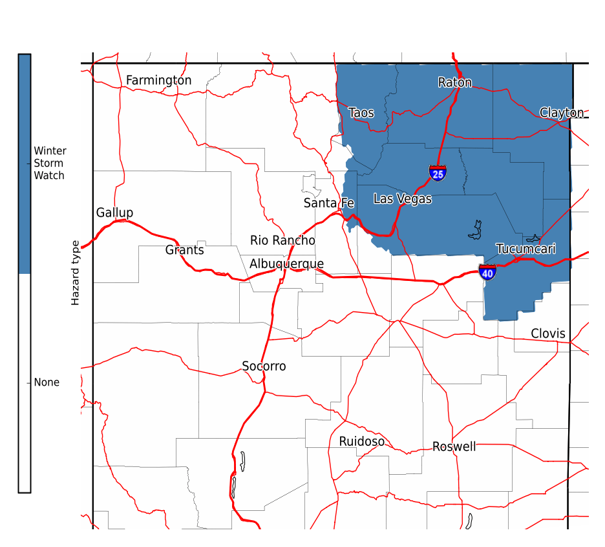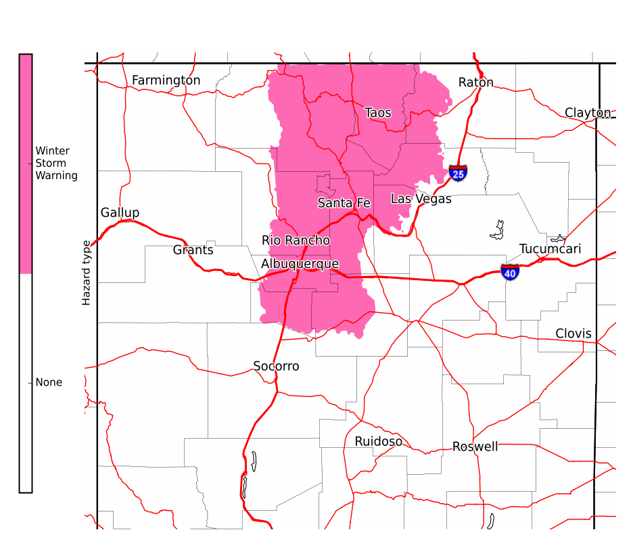
Winter storms can be just as hazardous as any other type of weather, and it's equally important to be prepared. Winter storms can last days, make travel impossible, and knock out power and communication systems. Don't underestimate the power of winter storms, and be sure to take the necessary steps in order to protect yourself.
Ready...Most hazardous weather is forecast days in advance. Begin your preparations by paying attention to the weather forecast. The Key Impacts Graphic is a great product issued by the National Weather Service that highlights the potential for hazardous weather over the next seven days.
Set...If a winter storm is possible, then a Winter Storm Watch will be issued. This means that conditions are favorable for a winter storm to occur, but some aspects such as location, timing, and snow amounts may still be uncertain. Pay attention and listen to your NOAA weather radio or tune in to your local broadcast media for the latest information. Start gathering supplies and have a plan in place that includes what you will do during the storm.
Go! As the event becomes imminent, then the Winter Storm Watch will be upgraded to a Winter Weather Advisory or a Winter Storm Warning. This indicates a threat to life and property, and travel will become dangerous if not impossible.
 |
 |
| When conditions are favorable for a winter storm, then a Winter Storm Watch will be issued. A Winter Storm Watch is a zone-based product, and it is issued at least 24 hours before the event is expected. | As the event becomes imminent, then the Winter Storm Watch will be upgraded to a Winter Weather Advisory or a Winter Storm Warning. Both are zone-based products. |
Staying indoors and off the roads is a great start in protecting yourself in the event of a winter storm, but you do face hazards indoors as well. Take extra steps to ensure you are properly heating your home.
Power outages are a common hazard during a winter storm. If you experience a power outage, use a battery-powered flashlight or lantern. If you use candles, do not leave them unattended as they can become a fire hazard.
Extreme cold often accompanies winter storms which can wreck havoc on water pipes in your home. When you're expecting very cold temperatures, leave water taps on a drip to prevent freezing. Allow heat to reach your pipes by leaving cabinet doors open. If your pipes do freeze, do not try to unfreeze them with a torch. Use an electric hair dryer to slowly thaw them.

If you must travel, be sure to check road conditions before you leave. In New Mexico, you can check the latest road conditions on nmroads.com or by dialing 5-1-1. Do not travel alone and keep an emergency kit in your car in case you get stranded. Keep your gas tank full. If you get stuck, pull over to the side of the road and stay in your car. Even a short walk during a winter storm can be dangerous.
 |
Know the signs of hypothermia and frostbite. Hypothermia is an unusually low body temperature. Symptoms include shivering, exhaustion, fumbling hands, memory loss, confusion, slurred speech, or drowsiness. If you suspect someone has hypothermia, seek medical attention immediately. Frostbite is an injury caused by freezing of the skin and underlying tissues. Frostbite is most common on extremities such as fingers, toes, ears, and nose. Signs of frostbite include numbness, red, white, or grayish-yellow skin, or hard or waxy-looking skin. If you notice signs of frostbite, seek medical attention. |